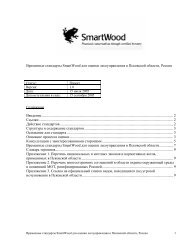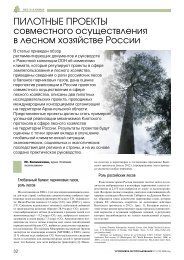Russia-China Timber Trade_cover.jpg
Russia-China Timber Trade_cover.jpg
Russia-China Timber Trade_cover.jpg
Create successful ePaper yourself
Turn your PDF publications into a flip-book with our unique Google optimized e-Paper software.
Chinese provinces. Pulp is primarily exported from large <strong>Russia</strong>n pulp and paper mills located in EasternSiberia and Northwest <strong>Russia</strong>. It is delivered mainly by rail, through Zabaikalsk and Naushki customs. It shouldbe noted that, although the Chinese imports of <strong>Russia</strong>n timber are concentrated in Suifenhe, Manzhouli, andErlianhot, these railway points are not final consumption areas. Thirteen provinces and municipalities directlyimported <strong>Russia</strong>n timber in 2004. The top five were Inner Mongolia, Heilongjiang, Jiangsu, Liaoning, and Shandong.As Table 5 shows more than 91% of the timber was exported to two provinces: Inner Mongolia andHeilongjiang.<strong>Russia</strong>n timber imported by ship goes to the following coastal cities – Taicang in Jiangsu Province (3.1% of thetotal import), Dalian in Liaoning Province (1.9%), Yantai in Shandong Province (0.9%), Ningbo in ZhejiangProvince (0.5%), and the Shanghai Municipality (0.4%)[5]. Most of the timber exported by ship is from RFEports; with only about 6% is delivered via seaports in Northeast <strong>Russia</strong>.Key exporters and importers and their supply chainsA wide network of logging, timber processing and silvicultural enterprises in Khabarovskiy Kray, PrimorskiyKray and Amurskaya Oblast characterizes the wood supply chains of major RFE exporters. The largest enterpriseis Primorskiye Lesopromyshlenniki (Primorslesprom), which includes 16 logging and 27 timber-processingcompanies. All companies have long-term leases to forest lands. At the same time, the low level of timberprocessing in these companies has to be considered. There are no facilities for production of fibre or chipboardand veneer.Of the top twenty <strong>Russia</strong>n roundwood exporters to <strong>China</strong>, 14 are from the RFE and 6 are from Eastern Siberia(Figure 5). In total, they comprise about 25 percent of the <strong>Russia</strong>n roundwood export to <strong>China</strong>. Only about onethirdis traders; the rest are logging companies.As a rule, major exporters are either the former large state timber companies, which were subsequently privatized,or companies with considerable foreign investment. Most of them also previously specialized in exportingtimber to Japan but recently transferred their business to the Chinese market, due to more competitive pricesand greater flexibility with timber export requirements and quality. With the exception of traders, they all havelong-term timber leases and processing facilities. They also have skilled staff and have developed long-termrelationships with government agencies and customs authorities. In addition to their own sorting yards, storagesites, and railway or port terminals, these companies also export on behalf of other harvesters and smalltraders.Prior to 1998, there were just a few Chinese importers. Now there are hundreds of private Chinese companiesinvolved in the trade. The number of Chinese importers as declared by <strong>Russia</strong>n exporters increased 2.5 times,from 190 in 1998 to 475 in 2002 [3]. Most importers emerged from state-owned trading companies or werecreated by provincial or local governments. Although most of these traders are ostensibly private, with limitedThousand, cum450400350300250200150100500FloraSmena-TradingDalLesPromRimbunanHidjau DVTyndaLesPrim Lesopromyshle...Zeiskii LPKAsian-CargoHolding MTK-CentrBaikalskaya LKTaiga ExMaltatRimbunanHidjau Int...DalnerechenskLesForeast-StarmaYuantunAsia-ExportTranskortPIK-89Pertsev (private)Figure 5. Top 20 <strong>Russia</strong>n roundwood timber exporters to <strong>China</strong>, 2003.11

















